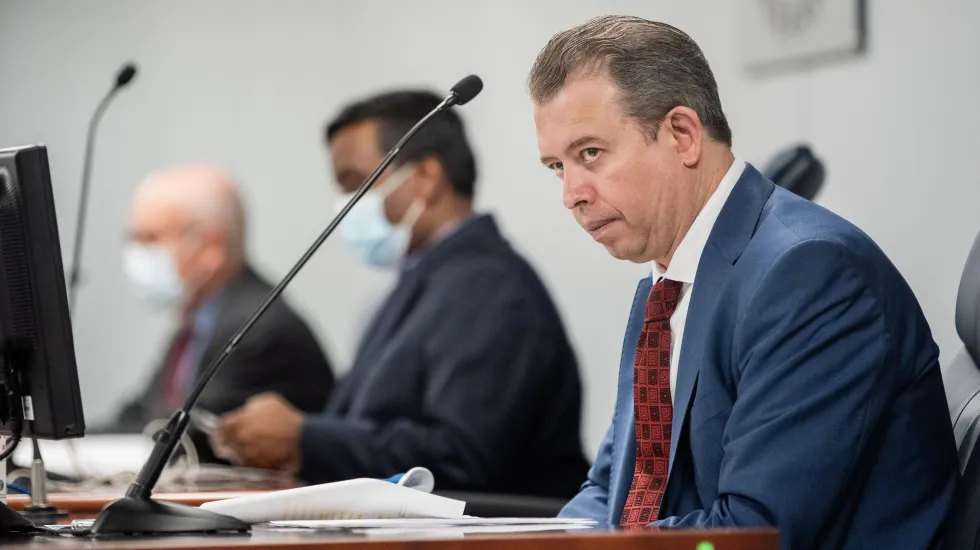
After weeks of complaints that school budgets are being slashed at a time when kids need more resources to get through the pandemic, a school board member urged Chicago Public Schools CEO Pedro Martinez to better communicate the funding changes that he says are in fact leading to increased funding rather than cuts.
About 150 parents with several community groups rallied outside CPS’ Loop headquarters Wednesday ahead of the monthly Board of Education meeting to decry budget cuts at their schools. Many parents and educators have spent the past month having difficult conversations about teacher and support staff positions they would have to eliminate because their school was allocated fewer dollars for next school year.
In front of a crowd chanting “free the funds” in reference to federal COVID-19 relief money sent to CPS, Mariana Alvarez said she and fellow parents “need answers. ... Why are these budget cuts taking place?”
“Every student in all neighborhoods should be privileged to the same resources and education as every other student,” Alvarez said. Funding limitations at her fourth grade son’s school have meant he was placed in a mixed classrooms with third graders, she said as state officials and CTU leaders watched on in support.

In unveiling the budgets last month that identify how much money each principal will be given to spend at their school, Martinez touted 60% of schools receiving budget increases. CPS data shared with reporters showed the average increase was $330,030, while the average cut at the remaining 40% of schools was $222,471. In all, 177 schools lost at least $100,000, which at 74 schools accounted for at least 5% of their budgets.
Even so, Martinez said at Wednesday’s meeting that he was frustrated by budget talk the past few weeks being dominated by “information that is either incomplete or, frankly, not fully factual.”
Any cuts could be due to a couple reasons, he said. First, the district is deploying a redistribution of resources from schools that were over-staffed to buildings that were missing teachers. The district is also shifting the responsibility for some positions to CPS’ central budget instead of individual school budgets — meaning principals won’t have to decide whether to pay for those positions, they’ll automatically have the money. But with some of those adjustments being unveiled on a rolling basis, many schools are seeing what looks like reduced budgets right now.
CPS to hire 1,600 teachers: CEO
The truth, Martinez said, is the district plans to hire almost 1,600 teachers across the district, not cut positions; introduce arts programming at every single school; eliminate split-grade classes caused by financial constraints; place at least one intervention teacher at every school to help kids who are struggling academically; and offer staff greater access to professional development. All those initiatives represent investments in schools, he said, stressing that all federal relief funding is either in use or being earmarked for use by the government’s September 2024 deadline. At past school board meetings, though, board members have urged the district to use that money sooner to address students’ pressing needs.
“We engaged our school and our principals to focus on, and really ask the question, ‘How do we make sure our schools are set up for success?’ We focused on making sure the resources are there to improve classroom instruction, to provide increased social and emotional supports and to look at equity across our system,” Martinez said.

Any schools that are still facing programmatic losses can work with district officials to restore funding, he said. In some cases, like Zapata Academy, where teachers and parents raised concerns about hundreds of thousands in cuts, Martinez said some of that money was returned to the school when it became clear vital programs would be dropped.
CTU President Jesse Sharkey, who a couple hours earlier outside at a press conference had called on the district to reverse any cuts, said he appreciated Martinez’s comments that the budget issues are more complicated than they might have first appeared to staff and parents — but that’s part of the problem.
Principals had to bring their budgets for a vote by their Local School Councils last week, and many of those budgets had cuts in them. While appeals are still happening and some funding might be restored — plus additional resources that will be centrally funded — educators and communities already got word of cuts, budgets were approved and staff now believe they’re being targeted for layoffs.
“If a school loses 50 kids [in special education] and there’s another school that gains 50, you can’t just say we’re never going to move people around the district,” Sharkey acknowledged. “But what you do instead, you lay off dozens or hundreds of special educators and then at some point in the future you’re going to try to rehire. ... What do you think the teachers who have been laid off are going to do in the meantime? They’re going to look for other work and they’re going to find other work.”

Board member Elizabeth Todd-Breland said she supports redistributing resources for equitable funding, but those changes should have been communicated to school communities much sooner to avoid confusion that even she as a board member is experiencing.
“Given this was such a fundamental change in the way that budgeting is being done, there needs to be more engagement,” Todd-Breland said. “LSCs had to vote on what they only knew was the school-based budget when there are going to be other things layered on top. And so how do you make a decision without full information? That feels like a really difficult thing to ask of our Local School Councils.
“The fabric our school communities is worn thin. And every time there’s a misstep in communication, every time there’s not full information or full transparency, it further rips and tears at that. ... I have not felt overcommunicated to about this. I don’t think our communities feel overcommunicated to about this.”







